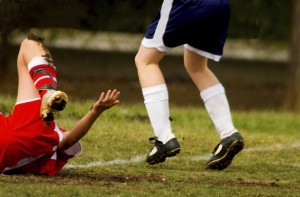How to Prevent Overuse Injuries in Your Young Child or Teenager
The benefits of participating in sports for school-age children are almost too many to count: sports help keep children healthy, trim, away from drugs; they help children develop social skills, discipline, a sense of fair play, self-esteem, and so on.
But getting carried away with sports — especially the competitive ones — can cause injuries to your child that could last them their entire lives. This is particularly the case when a child specializes in a single sport at a young age or when the child spends too many hours a day involved in physical activities.
We’re not talking here about acute injuries, which can occur randomly and in an instant, and which can be partially prevented by using protective equipment. Here, we’re discussing overuse injuries, which happen over a period of time, and which account for half of all sports injuries in American children and teens.
Overuse injuries are caused by repetitive motions, which put excess stress on bones, muscles and ligaments. Children and teenagers are at greater risk of developing overuse injuries because their still-growing bones are less able to handle ongoing repetitive stress.
Overuse injuries can happen to adults also; but they are that much more important to avoid in children because of how they may alter bone growth.
The following are three common types of overuse injuries in school-age athletes:
- Little league elbow: this is pain and tenderness in the elbow, resulting from repetitive throwing. Other than the pain, pitchers can sometimes lose velocity and endurance in the arm
- Spondylolysis: this condition can occur from trauma or from repetitive flexing, overextending, twisting or compression of the back muscles. Spondylolysis is the deterioration of the projections in individual vertebrae that help pivot vertebrae relative to one another and attach to adjacing muscle. The condition can cause back pain and commonly happens to children who play soccer or football, or who practice gymnastics, wrestling, weight-lifting or diving
- Shin splints: these involve pain in the front of the lower legs. They are caused by running on a hard surface or by training too rigorously at the start of a season
To decrease chances of sustaining overuse injuries, doctors recommend that children warm up and stretch thoroughly before and after each session.
In addition, children should not specialize in one sport at too young an age; it is better to wait until mid-adolescence or later to specialize in a sport. It is a good idea to keep in mind that growth spurts can increase the possibility of overuse injuries; doctors advise parents to encourage their children to play a variety of sports, especially while the children are still growing.
Another thing that your child can do to avoid overuse injuries is to wear appropriate gear when practicing a sport (for instance, shoes with plenty of cushioning for running sports). Using proper technique will also help prevent injury.
Doctors also recommend that a growing child not overengage in sports as a whole. For example, playing multiple sports in the same season can increase risk of repetitive sports injury because not enough time is allowed for the different muscle groups and body parts to heal between practices or workouts.
A recent study from Chicago on sports-related overuse injuries in school-age children found that when children spent more time practicing an organized sport than in free play, the risk of overuse injuries went up. The study also found that when children spent more hours in active play per week (whether an organized sport, free play or both) than the child’s age — such as more than 10 hours for a 10-year-old boy or girl — the risk of overuse injuries increased.
Researchers in that study recommended to parents not to let kids overdo it with any one sport or spend too many hours a day or a week engaging in sports and free play.
If a child is specializing in a sport, some sports medicine doctors recommend that the child not participate more than 3 or 4 days a week, and that parents only allow the athlete to participate for 7 or 8 months of the year.
Reinjuries
If a young athlete has been injured, it is important to let the body heal fully before resuming participation in a sport; returning to the sport before an injury has completely healed increases the chances of a reinjury. Additionally, it forces the body to compensate for the parts that haven’t fully healed, and this can result in injury of other body parts.
In case of an overuse injury, you may want to have your child be examined by a doctor, who can decide if rest will be sufficient to heal the damage, or if the child should be seen by a sports medicine specialist. Getting overuse injuries diagnosed and treated may keep an injury from developing into a bigger and more lasting problem.
By Marc Courtiol

Leave a Reply